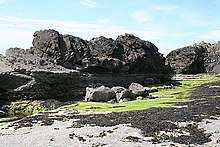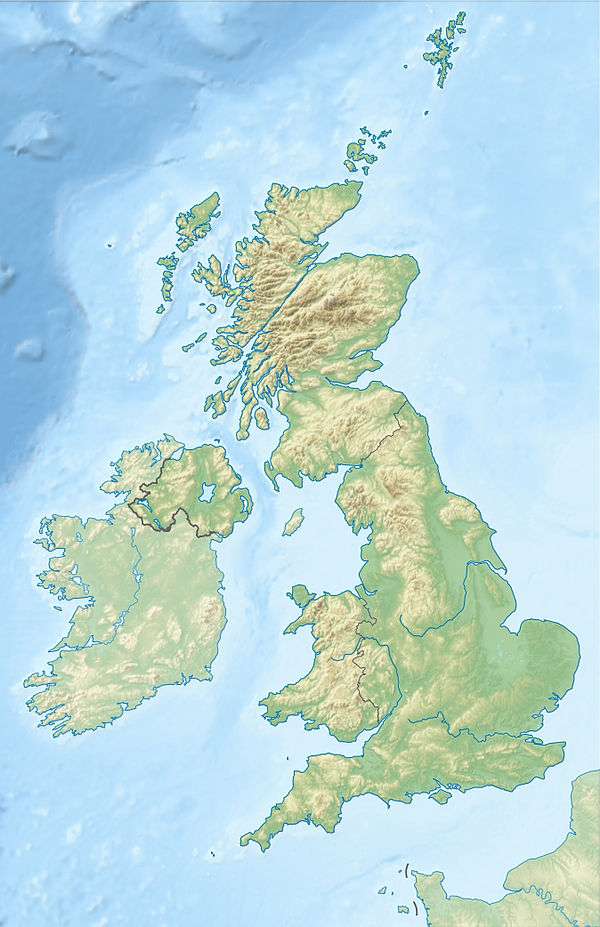Kilmaluag Formation
The Kilmaluag Formation is a Middle Jurassic geologic formation in Scotland. It was formerly known as the Ostracod Limestone for the abundance of fossil freshwater ostracods within it. The Kilmaluag Formation is very fossiliferous, with ostracods, gastropods, bivalves, trace fossil burrows, and vertebrate fossil remains. Vertebrate fossils include fish, crocodilomorphs, mammals, small reptiles, amphibians and some large reptile remains including dinosaurs and pterosaurs[1].
| Kilmaluag Formation Stratigraphic range: Bathonian ~167.4–166.5 Ma | |
|---|---|
 Sediments of the Kilmaluag Formation overlain by Paleogene lava on the Isle of Skye | |
| Type | Formation |
| Unit of | Great Estuarine Group |
| Underlies | Skudiburgh Formation |
| Overlies | Duntulm Formation |
| Thickness | Up to 25 m (82 ft) |
| Lithology | |
| Primary | Calcareous mudstone, limestone |
| Other | Marl |
| Location | |
| Coordinates | 57.2°N 6.1°W |
| Approximate paleocoordinates | 46.6°N 4.6°E |
| Country | |
| Extent | Throughout Inner Hebrides, including Isle of Skye, Isle of Muck, and Isle of Eigg |
| Type section | |
| Named for | Kilmaluag Bay in the North of Skye |
 Kilmaluag Formation (the United Kingdom)  Kilmaluag Formation (Scotland) | |
Geology
The Kilmaluag Formation is Bathonian,and dates to around 167 million years old. It is part of the Great Estuarine Group of the Hebrides Basin, a series of sediments laid down as the land rose and fell in the area running between what is now mainland Scotland the Outer Hebrides, causing the environment to alternate between a warm shallow sea and more exposed dry land and lagoons.[2]
The Kilmaluag Formation is composed of dolomitised limestones, fine grain sandstones, and mudstones, indicating that it alternated between a shallow environment, and lagoonal mudflats as the basin subsided and rose.[3] These mudflats sometimes dried out to form desiccation cracks. The Kilmaluag Formation is unusual among the Estuarine Group for the freshwater environment it preserves, whereas many other formations in this group are predominantly brackish to marine in nature.[2] In many beds, freshwater gastropods and bivalves can be found, including Viviparus and Unio, and freshwater ostracods such as Darwinula.[3][2]
Fossils
Many vertebrate fossils are found in the Kilmaluag Formation, and it has been explored by palaeontologists since the 1970s, when the first mammal fossil was found there by Michael Waldman. He returned with fellow palaeontologist Robert Savage and they collected more fossils and named two new species from the area: the Docodont Borealestes serendipitus, and the tritylodontid, Stereognathus hebridicus[4] (although S. hebridicus is now thought to be a junior synonym to S. ooliticus[5]). Many other fossils are found in the Kilmaluag, including members of other Mesozoic mammal groups, turtles, reptiles, and amphibians.[1][6] The most recent discoveries in the Kilmaluag Formation include Palaeoxonodon ooliticus[7] and Wareolestes rex.[8] and the tooth of a sauropod dinosaur.[9]
Comparisons between the Kilmaluag Formation and other sites in the UK and rest of the world suggest that the fauna represented there is globally significant, due to the rarity of fossils from the Middle Jurassic[1]. The fauna is a subset of the animals represented in the Forest Marble Formation in England, but fossils in the Kilmaliag Formation are substantially more complete. However, most material can only be studied using micro-CT scanning making it difficult to collect and study.
Exposures of the Kilmaluag Formation are protected by law as SSSIs (Site of Special Scientific Interest) and under the new Scottish NCO (Nature Conservation Order), and no public collection is permitted. Most fossils found to date are held in the collections of the National Museum of Scotland.
Vertebrate paleobiota
Amphibians
| Amphibians | ||||||
|---|---|---|---|---|---|---|
| Genus | Species | Location | Stratigraphic position | Material | Notes | Images |
| Marmorerpeton[6] | M. kermacki | Cladach a'Ghlinne | Salamander | |||
| Caudata[6] | Indeterminate | Cladach a'Ghlinne | Referred to as "Kirtlington 'Salamander A'" | |||
Turtles
| Turtles | ||||||
|---|---|---|---|---|---|---|
| Genus | Species | Location | Stratigraphic position | Material | Notes | Images |
| Eileanchelys[10] | E. waldmani | Cladach a'Ghlinne | Partial skull and association of 5-6 individuals with skull and shell material. | |||
| Testudines[6] | Indeterminate | Cladach a'Ghlinne | ||||
Lepidosauromorphs
| Lepidosauromorphs | ||||||
|---|---|---|---|---|---|---|
| Genus | Species | Location | Stratigraphic position | Material | Notes | Images |
| Marmoretta[11] | M. oxoniensis | Cladach a'Ghlinne | Partial associated skeleton | Stem-lepidosauromorph | ||
| cf. Paramacellodus[6] | Indeterminate | Cladach a'Ghlinne | ||||
| Parviraptor [6] | Indeterminate | Cladach a'Ghlinne | Stem-snake (disputed) | |||
| Squamata[6] | Indeterminate | Cladach a'Ghlinne | Distinct from other taxa known from the British Bathonian, new gen et sp indet. | |||
Choristoderes
| Choristoderes | ||||||
|---|---|---|---|---|---|---|
| Genus | Species | Location | Stratigraphic position | Material | Notes | Images |
| Cteniogenys[6] | Indeterminate | Cladach a'Ghlinne | Partial skull | |||
Dinosaurs
| Dinosaurs | ||||||
|---|---|---|---|---|---|---|
| Genus | Species | Location | Stratigraphic position | Material | Notes | Images |
| Eusauropoda[9] | Indeterminate | Cladach a'Ghlinne | Tooth | |||
Mammaliamorphs
| Mammaliamorphs | ||||||
|---|---|---|---|---|---|---|
| Genus | Species | Location | Stratigraphic position | Material | Notes | Images |
| Borealestes[12] | B. serendipitus | Cladach a'Ghlinne | Toothed jaw fragments, referred partial skeleton[13] | |||
| Krusatodon[6] | Indeterminate | Cladach a'Ghlinne | Molar | |||
| Palaeoxonodon[7] | P. ooliticus | Cladach a'Ghlinne | Three partial left dentaries[14] | |||
| Stereognathus | S. ooliticus[5] | Cladach a'Ghlinne | Partial toothed jaw, isolated teeth | |||
| Wareolestes[8] | W. rex | Partial left dentary | ||||
References
- Panciroli E, RBJ Benson, S Walsh, RJ Butler, TA Castro, MEH Jones, SE. Evans. 2020. Diverse vertebrate assemblage of the Kilmaluag Formation (Bathonian, Middle Jurassic) of Skye, Scotland. Earth and Environmental Transactions of the Royal Society of Edinburgh [online] 1-22
- Andrews, J. E. 1985 The sedimentary facies of a late Bathonian regressive episode: the Kilmaluag and Skudiburgh Formations of the Great Estuarine Group, Inner Hebrides, Scotland. Journal of the Geological Society of London, 142, 1119-37.
- Barron, A. J. M., Lott, G. K. and Riding, J. B. 2012 Stratigraphical framework for the Middle Jurassic strata of Great Britain and the adjoining continental shelf. British Geological Survey Research Report, RR/11/06. British Geological Survey, Keyworth
- Waldman, M and Savage, R.J.G 1972 The first Jurassic mammal from Scotland. Journal of the Geological Society of London 128:119-125
- Panciroli, Elsa; Walsh, Stig; Fraser, Nicholas C.; Brusatte, Stephen L.; Corfe, Ian (2017-09-03). "A reassessment of the postcanine dentition and systematics of the tritylodontid Stereognathus (Cynodontia, Tritylodontidae, Mammaliamorpha), from the Middle Jurassic of the United Kingdom". Journal of Vertebrate Paleontology. 37 (5): e1351448. doi:10.1080/02724634.2017.1351448. hdl:10138/230155. ISSN 0272-4634.
- Evans, S., Barrett, P., Hilton, J., Butler R.J., Jones, M.E.H., Liang, M-.M., Parrish, J.C., Rayfield, E.J., Sigogneau-Russell, D., and Underwood, C.J. 2005. The Middle Jurassic vertebrate assemblage of Skye, Scotland. 36-39. In P. Barrett and S. Evans (eds). Proceedings of the Ninth Symposium on Mesozoic Terrestrial Ecosystems and Biota. Natural History Museum, London.
- Close, Roger A.; Davis, Brian M.; Walsh, Stig; Wolniewicz, Andrzej S.; Friedman, Matt; Benson, Roger B. J. (2015-11-13). "A lower jaw of Palaeoxonodon from the Middle Jurassic of the Isle of Skye, Scotland, sheds new light on the diversity of British stem therians". Palaeontology. 59 (1): 155–169. doi:10.1111/pala.12218. ISSN 0031-0239.
- Panciroli, Elsa; Benson, Roger B. J.; Walsh, Stig (2017-05-04). "The dentary of Wareolestes rex (Megazostrodontidae): a new specimen from Scotland and implications for morganucodontan tooth replacement". Papers in Palaeontology. 3 (3): 373–386. doi:10.1002/spp2.1079. ISSN 2056-2802.
- Barrett, Paul M. (March 2006). "A sauropod dinosaur tooth from the Middle Jurassic of Skye, Scotland". Earth and Environmental Science Transactions of the Royal Society of Edinburgh. 97 (1): 25–29. doi:10.1017/S0263593300001383. ISSN 1473-7116.
- Anquetin, J.; Barrett, P.M.; Jones, M.E.H.; Moore-Fay, S.; Evans, S.E. (2009). "A new stem turtle from the Middle Jurassic of Scotland: new insights into the evolution and palaeoecology of basal turtles". Proceedings of the Royal Society B: Biological Sciences. 276 (1658): 879–886. doi:10.1098/rspb.2008.1429. ISSN 0962-8452. PMC 2664364. PMID 19019789.
- Waldman, M.; Evans, S. E. (1994). "Lepidosauromorph reptiles from the Middle Jurassic of Skye". Zoological Journal of the Linnean Society. 112 (1–2): 135–150. doi:10.1111/j.1096-3642.1994.tb00315.x.
- WALDMAN, MICHAEL; SAVAGE, ROBERT JOSEPH GAY (March 1972). "The first Jurassic mammal from Scotland". Journal of the Geological Society. 128 (2): 119–125. doi:10.1144/gsjgs.128.2.0119. ISSN 0016-7649.
- Panciroli, Elsa; Schultz, Julia A.; Luo, Zhe-Xi (2018-08-31). "Morphology of the petrosal and stapes of Borealestes (Mammaliaformes, Docodonta) from the Middle Jurassic of Skye, Scotland". Papers in Palaeontology. 5: 139–156. doi:10.1002/spp2.1233. ISSN 2056-2802.
- Panciroli, Elsa; Benson, Roger; Butler, Richard (2018). "New partial dentaries of amphitheriid mammalian Palaeoxonodon ooliticus from Scotland, and posterior dentary morphology in early cladotherians". Acta Palaeontologica Polonica. 63. doi:10.4202/app.00434.2017. ISSN 0567-7920.